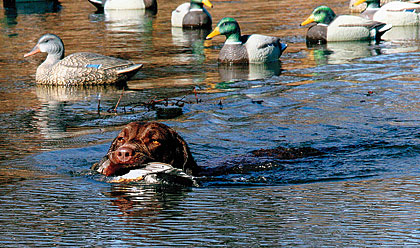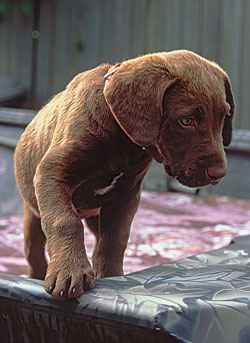While not designed for everyone, the Chesapeake Bay retriever can be both a fine companion and an outstanding hunter.
By Gary Koehler
 Kayla, the author's Chessie, displays the can-do attitude that most CBRs seem born with. |
For some odd reason, my introduction to the Chesapeake Bay retriever seems like it took place only yesterday. In fact, that chance meeting occurred more than 50 years ago on the banks of Lake Senachwine, an Illinois River backwater whose reputation as a duck hunting Mecca can be traced to the horse and buggy.
It was late October, and I was accompanying my father on a one-day trip to our family cabin. We were there to clean up the yard, raking leaves and such. When he signaled for a break, I wandered down to the lake.
There I met our friend Ed Hall, a tried-and-true river rat who, over the years, ran commercial fishing nets, trapped, rented leaky wooden boats to unsuspecting fishermen and guided duck hunters on his grounds across the lake.
Most of Ed's waterfowling clientele were Chicago-area folks. And the long, sparkling-new station wagon parked on the sand beach said this day's client was yet another high roller. The vehicle was top-of-the-line impressive.
This being mid-afternoon, the duck hunting was done for the day. I figured they had likely shot a few ducks earlier, so I asked Ed where the birds might be so I could take a look.
"Back of that fancy car," he said. "But don't be putting your hand down there and picking any up 'cause there's a Chesapeake in there and he'll take your arm off." Ed was not smiling.
Huh? I'd been around all sorts of dogs, and none had ever come with such a stern warning. These Chesapeakes must be monsters.
"He won't do anything to you, boy," the hunter said. "You can look at any of those ducks you want."
I approached the back of the vehicle with more than a little trepidation. Ed, after all, always seemed to be right about things dealing with animals, birds or fish. The car's rear window was rolled down. There, sprawled out in the cargo area, was a marsh-grass-colored, block-headed Chesapeake Bay retriever. Four ducks lay alongside the dog.
Gulping first, I reached over the tailgate and gingerly picked up a mallard drake. The dog didn't even flinch. So much for the all-Chessies-will-eat-you-alive myth.
Five years ago, I acquired my own Chesapeake Bay retriever, whom we named Our Lady Vol Kayla. Ironically, one of the ancestors listed on her pedigree was Senachwine's Shiloh. Could Kayla be related to that dog I met many, many years ago? I will never know for sure.
One thing I do know, however, is that Kayla is unlikely to bite anyone reaching for a duck. Selective breeding has, for the most part, eliminated the aggressive, mean-spirited Chesapeakes assigned to guard market hunters' boats and gear a hundred years ago. Please do not misunderstand: There are Chessies out there who would never consider walking away from a fight, or would think nothing of starting a fracas. But that could also be said of individual dogs representing many other breeds.
"Fortunately, breeders over the years have become much more discriminating," said my friend Butch Goodwin, who raised and trained Chesapeakes and other retrievers for 30 years. "People don't want that 'toughest dog at the boat ramp' anymore. I suppose there are still a few people out there who still want that, but I personally think their numbers are quite small."
A year or so prior to purchasing Kayla, I visited Goodwin's Idaho kennel. My purpose was to discuss the breed at length with an experienced breeder/owner, and see firsthand how his dogs behaved with a stranger in the house. The two he let into the living room that day did little more than give me a cursory glance before picking a spot to lie down on the carpet.
I've come to believe that the Chesapeake may be the most misunderstood sporting dog on the planet. The Chesapeake's perceived anti-social temperament is perhaps the single most important reason the breed's numbers have not soared like those of the Labrador and golden. Indeed, the American Kennel Club listed Chessies 49th last year in terms of breed registration numbers. The Lab was No. 1 for the 19th straight year. Golden retrievers ranked fourth. The initial ranking, which occurred 126 years ago, had the Chesapeake No. 2 overall, second behind only the pointer.
But perhaps the Chesapeake's middle-of-the-pack popularity is not a bad thing. They are not being over-bred like some other breeds. Breeders have worked extremely hard to ensure a milder temperament and, if anything, an improved standard. Plus, quite frankly, Chessies are not for everyone. They are not an extension of the Lab family and should never be thought of as such.
 The writer's beloved Chessie, Kayla, as a puppy. |
Many Labs--which are wonderful dogs, by the way--will often frolic and play and try to be everyone's best friend. Not so the Chessie. Although there are exceptions, they are probably more likely to be more reserved or standoffish among strangers. That being said, the first time my son-in-law visited, Kayla crawled up on his lap and seemed perfectly happy to lick the new face in the house.
We have learned that Chessies can be scary loyal. Kayla is waiting for me at the door every night when I come home from work. When I'm occasionally on the road for business, my wife takes care of the dog. Sometime that has its glitches.
"Every time she hears the garage door open, she's up and looking for you. When she sees it isn't you, she lies back down," my wife reported following my last trip out of town. "I put her food out, but she wouldn't touch it. She went two full days without eating this time."
Canine hunger strikes are not a particularly good thing, but Kayla's behavior illustrates how Chesapeakes can bond with their owner. And, yes, that's owner, singular. Kayla listens to my wife. She nuzzles up to my wife and daughters to get petted. She tolerates family, friends and other visitors. But make no mistake: She's my dog first and foremost. That's the Chessie mindset, or at least hers. What Kayla will do for me when instructed is far more complex and demanding than what she'll do for anyone else.
Training a Chesapeak
e can be challenging. Pat Baughman, an old friend who has raised, trained, campaigned and hunted Chessies for more than 25 years, encouraged my acquiring a Chesapeake. We talked extensively about the breed before I got Kayla, and he was quite candid in explaining what to expect from the breed.
"You'll hear all kinds of things from people who say they can't be trained, which is just silly," Baughman said years ago. "But it does take time. Training a Chessie is not like training a Lab. They're different. Know that going in. Chessies might take a little more time, but once they get it, they don't forget it."
Amen to that. Kayla forgets nothing. Even the bad stuff that she's not supposed to do, like where to look for loose socks. She considers running around the house with her finds great fun. Whenever someone leaves a sock on the floor, on a chair or wherever, she's on it and off to the races.
A number of people tried to talk me out of getting a Chessie. They told me most trainers didn't want anything to do with the breed. "You'll be training that dog with a 2-by-4" was the most common refrain, usually followed by a "ha, ha." Well, those concerned citizens were wrong. All wrong.
Some people may need to employ a heavy hand in training their dog. But with Kayla, it was the just the opposite. I quickly learned she did not like being yelled at; she responded much better to a calm but firm tone. And she certainly did not like being whacked on the rump, which I made the mistake of doing one time. She immediately sat down and looked up at me, as if to ask, "What the heck are you doing?"
Patience remains a key in our training regimen. Slow and easy, one-thing-at-a-time is much more productive than trying to jam a whole bunch of tasks into a single session. I wholeheartedly advise taking Chessie pups to a structured obedience class.
Kayla attended two of them during the first 18 months we had her. The opportunity to socialize with other dogs was well worth the time. And with a formal class, everything is laid out in an orderly lesson format, from the "heel" to the "sit" to the "come" commands, and more.
"It doesn't matter how big or how little the dog is" said Dottie Fletcher, who taught both obedience classes. "All dogs should be under control. Obedience training helps you do just that. People wonder why their dogs misbehave. Well, in most cases it's because no one took the time to teach them anything."
Fletcher, who resides in the Memphis area, trained all manners of dogs for 50 years before retiring a couple of years ago. She clearly explained the importance of obedience training for sporting dogs.
"You will see that it sets the groundwork for all of your other training, like retrieving," Fletcher said. "Just remember to make it clear to the dog what you want it to do. You can't expect dogs to read your mind."
I'm convinced that dogs are happiest when they receive training. I think they enjoy the attention they are getting and, when praised, they feel better about themselves when they know they are pleasing you, the trainer. It's a confidence thing. It boosts their self-esteem. Or both. At least, that's the message Kayla conveys.
Oh, we had some issues during training. There's no dodging that. The old saying that one must convince a Chessie that the task at hand is its own idea is indeed valid. Figure out a way to make that happen and the dog will stun you with its drive. Channel the energy, tap into the intellect. There is not much they can't do.
But do not push anything to excess. Chessies can easily get bored, so repetition only goes so far. I used to toss a lot of bumpers, on land and water. And when Kayla was a pup, she was game for 10 or more retrieves. These days, a couple of throws and she's done. She shows me she knows exactly what to do and apparently figures it's time to move onto something else. And I can't argue, because she's not learning anything new.
If you plan on hunting your Chessie, it's likely your dog will have at least some natural ability or instincts in the field. Kayla is soft in the inside, but rugged on the outside. She thinks nothing of diving into frigid water or dealing with ice. Underbrush doesn't slow her down, and neither does mud.
Kayla can also be maddeningly stubborn at times.
While my Chessie education continues daily, there's one thing I can always count on: At the end of a terrible day at the office, or when everyone else in our house is upset with me over one thing or another, Kayla will always be there, sitting, waiting for me to come home. Her devotion is unconditional. And in my book, that's worth plenty.






